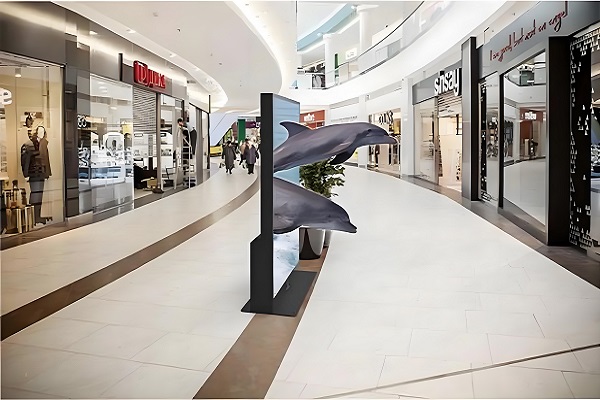In an age of information overload, advertisers are seeking novel and eye-catching ways to capture consumers’ attention. As an innovative advertising format, 3D effect screens, with their powerful visual impact and immersive experience, have gradually become an essential tool in brand marketing. According to statistics, 3D animation screen ads can increase viewer engagement time by over 30%, and brand recall is 50% higher than traditional 2D ads. This gives brands an opportunity to establish a deeper emotional connection with consumers, enhancing the overall effectiveness of the advertisement.
1. Overview of 3D Effect ScreenAds
Definition and Characteristics: 3D effect screens use 3D technology to display stereoscopic images without requiring special glasses. The main features include strong visual impact, high interactivity, and an immersive experience. Data shows that the average viewer engagement time for 3D animation screen ads is typically 15%-20% longer than for standard ads, allowing advertisers to capture consumer attention more effectively in a limited time.
Technology Behind It: 3D effect screens use techniques such as parallax and light-field technology to create a 3D visual effect that changes based on the viewer’s perspective. This technology is commonly used in large LED displays to create realistic 3D imagery. As the technology evolves, the cost of 3D animation screen has been steadily decreasing, and the number of commercial 3D screens has been growing year by year. By 2026, the global market for 3D effect screens is projected to reach $3.5 billion.
2. Advantages of 3D Effect ScreenAds
Strong Visual Attraction: Compared to traditional 2D ads, 3D effect screens can capture consumer attention quickly and increase brand exposure and recall. Studies have shown that brand recall for 3D screen ads is 30% higher than for flat ads, and consumers’ response times are also significantly improved.
Enhanced Brand Interactivity: 3D effect screen ads foster interaction with consumers, deepening the connection between brands and audiences. A 2019 survey revealed that 72% of respondents said they would pay more attention to a brand if the ad included interactive elements.
Immersive Brand Experience: 3D animation screen provide consumers with an immersive experience, which boosts brand recognition and affinity. According to a 2018 market survey, ads with immersive experiences can increase engagement by 60% compared to traditional ads.
3. Successful Case Studies
IWC’s “Big Pilot” Watch Ad: On outdoor screens at global landmarks, IWC displayed a 3D model of the “Big Pilot” watch breaking through a shipping container and rotating 360° to showcase intricate details. This creative ad increased the brand’s attention among its target audience by 40%, significantly boosting social media engagement.
Burberry’s “Little Deer” Ad: In key commercial districts in cities such as Wuhan, Hangzhou, New York, Tokyo, and Seoul, Burberry showcased a cute little deer in 3D effect screen ads. This enhanced the brand’s appeal and connection with consumers. The campaign raised Burberry’s brand recognition among younger consumers by 35% and increased sales of related products by 25%.

4. Design and Implementation Considerations
Relevance of Creative Content: The creative content of the ad should align with the brand’s image and product characteristics. Overly entertainment-focused or overly complex content can obscure the brand message and reduce the ad’s effectiveness. Market research shows that ads with creative content that aligns with the brand’s core values perform 15% better than ads that don’t.
Quality Assurance: Ensuring the technical quality of the 3D effect screen ad, such as smoothness and clarity, is critical to prevent technical issues from affecting the ad’s impact. Research indicates that ads with smooth technical execution can increase brand favorability by over 20%.
Precise Audience Targeting: By using data analysis to understand target consumers’ interests and needs, 3D screen ads can be designed to cater to their aesthetic preferences and interests. Data-driven targeting can improve ad click-through rates by approximately 20%.
5. Future Trends
Continued Technological Innovation: With ongoing advancements in technology, 3D effect screens will evolve into more innovative forms, such as multi-screen integration and holographic projection, enhancing the expressive power of ads. Market research suggests that 3D effect screen ads will see exponential growth in the next few years, and by 2028, the global market share for 3D screens could account for 8% of the overall advertising market.
Diversity of Advertising Formats: 3D effect screen ads will merge with other advertising formats, such as AR and VR, offering a more diversified advertising experience. A research report states that combining VR with 3D effect screen ads can increase brand loyalty by about 25%.
Data-Driven Precision Targeting: Future 3D animation screen ads will use big data analysis for precise targeting, which will enhance ROI. By analyzing consumer behavior, brands can optimize the timing and placement of their ads, leading to an estimated 18% increase in ad investment return.
Conclusion
3D screen ads, with their unique visual effects and interactivity, have successfully captured the attention of a wide range of consumers and become an essential tool in brand marketing. With thoughtful design and technological support, 3D animation screen ads can effectively attract consumers and enhance brand influence. As technology continues to develop, 3D effect screens will showcase even greater potential and value, bringing new vitality to the advertising industry.





